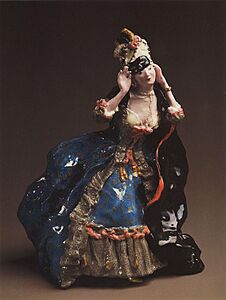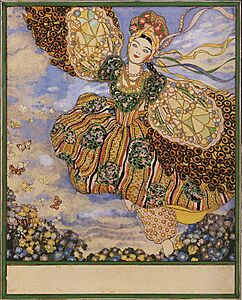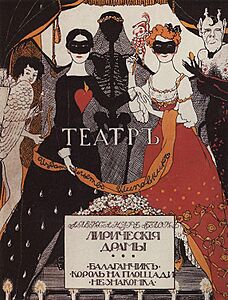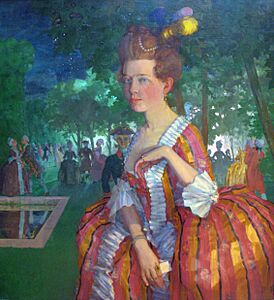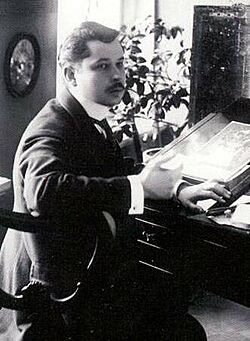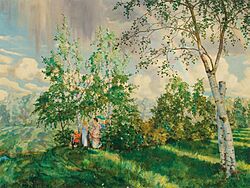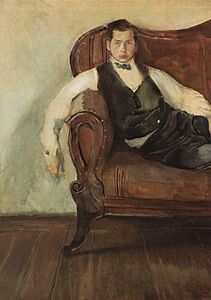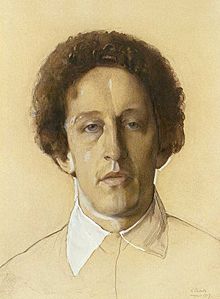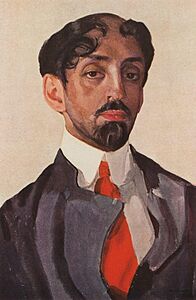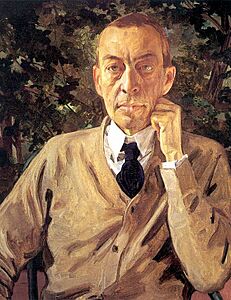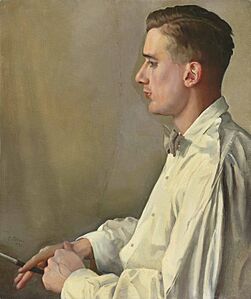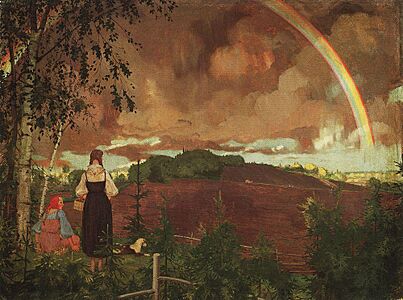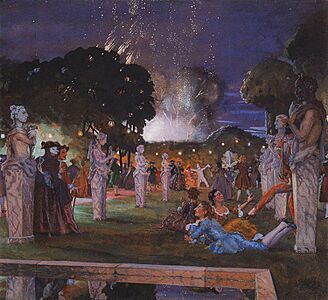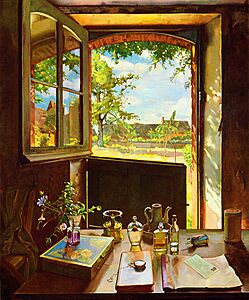Konstantin Somov facts for kids
Quick facts for kids
Konstantin Somov
|
|
|---|---|
| Константин Сомов | |
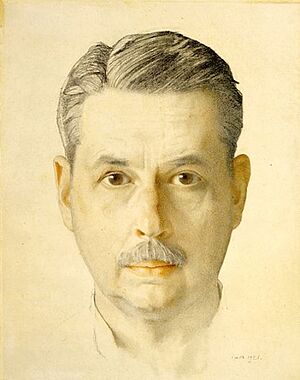
Self-portrait (1921)
|
|
| Born |
Konstantin Andreyevich Somov
November 30, 1869 |
| Died | May 6, 1939 (aged 69) |
| Education | Imperial Academy of Arts (elected Member, 1914); Académie Colarossi |
| Known for | Painting, Porcelain |
|
Notable work
|
Le Livre de la Marquise (1907-1919); The Rainbow (1927); The Boxer (1933) |
| Signature | |
Konstantin Andreyevich Somov (Russian: Константин Андреевич Сомов; November 30 [O.S. November 18] 1869 – May 6, 1939) was a Russian artist associated with the Mir iskusstva ("World of Art") movement that began in the last decade of the 19th century. After the Russian Revolution, he eventually emigrated to Paris, along with other prominent figures in the Russian arts. In private life, he had a longtime, younger male companion, Methodiy Lukyanov, and an ambiguous artistic and personal relationship with a young boxer, Boris Snezhkovsky, whom he painted many times. In the 21st century, his paintings have sold in the millions of dollars. In 2007, Somov's The Rainbow sold at Christie's London for GBP 3,716,000 (USD 7.33 million), an auction record for a Russian work of art.
Contents
Biography
Family and education
Konstantin Somov was born on November 30, 1869, in Saint Petersburg. He was the second son of Andrei Somov, art historian and senior curator at the Hermitage Museum. His mother, Nadezhda Konstantinovna, came from the noble family of the Lobanovs. She was well-educated and a musician. She instilled in her children a love of theater, music, and painting. The Somovs had a large private collection of old prints, paintings and drawings. Young Konstantin dreamed of becoming an artist from a very young age.
While a student at the Karl May School in Saint Petersburg, Somov became close friends with Dmitry Filosofov. Alexandre Benois, also a student, later wrote that "Some kind of magic circle separated them from the others." Later, Filosofov was sent to Italy due to illness, and Somov, who had a hard time studying science, was withdrawn from the school by his father. At the age of 20, Somov entered the Imperial Academy of Arts, where he studied under Ilya Repin, from 1888 to 1897. While at the academy, he met Sergei Diaghilev and Léon Bakst.
Somov traveled to Italy in 1890 and 1894, and the two winters he spent in Paris, in 1897 and 1898, he later recalled as the happiest days of his life.
Somov's first major success came a year before graduation from the academy. Somov and Benois spent the summer of 1896 at a dacha near Oranienbaum, in the village of Martyshkino. The landscapes and sketches he created there were highly praised by critics and colleagues. That year he also created illustrations for the works of Hoffmann.
In 1897 he successfully completed his studies at the academy and went to Paris to continue his education at the Académie Colarossi.
World of Art, career success
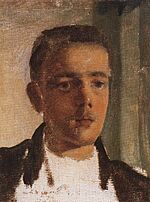
In 1898 and 1899, Somov was a founding member of Mir iskusstva (World of Art), a Russian artistic movement and magazine (edited by Diaghilev) that was a major influence on the Russians who revolutionized European art during the first decade of the 20th century. He served on the editorial board and contributed illustrations and designs.
For three years, from 1897 to 1900, he worked on his early masterpiece Lady in Blue (a portrait of Elizaveta Martynova), painted in the manner of 18th-century portraitists.
Along with landscape and portrait painting, watercolors, gouache, and graphics, Somov worked in the field of small plastic arts, creating exquisite porcelain compositions.
He had his first solo exhibition in Saint Petersburg in 1903 (162 paintings, sketches and drawings). Also in 1903, 95 of his works were exhibited in Hamburg and Berlin. In 1906, in a group show of Russian artists organized by Diaghilev, he exhibited 32 works at the Salon d'Automne in Paris. His work was particularly appreciated in Germany, where the first monograph on him, by Oskar Bie, was published in 1907.
During the 1910s, Somov executed rococo harlequin scenes and gallant scenes, as well as illustrations for books including poems by Alexander Blok.
Somov's modern idols were the English Pre-Raphaelites, Aubrey Beardsley, and James Whistler. His favorite masters of the past were French Rococo artists such as Watteau, Largilliere, Fragonard, and Boucher. His favorite poet was Paul Verlaine.
"By 1910, Somov was a famous and accepted painter, and just as every household of taste had a landscape by Benois and a dress designed by Bakst, so it had a miniature by Somov.…By 1917, judging by the high auction prices for his work…Somov must have been a rich man."
The colorful, festive visions created by Somov had a darker side. The Russian poet Mikhail Kuzmin noted:
Some kind of demon is constantly pushing the artist, as if a piece of a magic mirror from Andersen's fairy tale had hit him in the eye…Anxiety, irony, the puppet theatricality of the world, (...) the variegation of masquerade freaks, the false light of candles, the sorcery-skull hidden under rags and flowers, automatic love poses, deadness and creepiness of amiable smiles—this is the pathos of a number of Somov's works. Oh, how not cheerful is this gallant Somov! What a terrible mirror he holds up to the laughing holiday!
Alexandre Benois called Somov "one of the most delicate poets and one of the most refined masters of modern painting," even as he classified Somov's work as décadent and presciently wrote that "only with the decline of a culture do such figures appear as that of Somov…In virtue of all his merits and failings Somov may count… upon one of the most prominent places in the history of Russian painting…no other artist of the beginning of the twentieth century has mirrored with greater faithfulness the peculiar charm of our super-refined epoch, which knows so much and believes so little."
-
Title page, Alexander Blok's Theatre, 1909.
Russian Revolution, move to Paris
"Somov's reaction to the revolution was negative…One by one his colleagues emigrated, his clientèle disappeared overnight, and his retrospective pictures became meaningless to the new artistic consciousness." Nonetheless he became a professor at the Petrograd Free Art Educational Studios (the renamed Imperial Academy of Arts) in 1918, and in 1919 he celebrated his 50th birthday jubilee with a one-man exhibition at the Tretyakov Gallery.
Living conditions deteriorated in Russia. His apartment was nationalized, and he was later evicted. He struggled to retain the rights to his art.
Somov left Russia in 1923 to accompany the seminal exhibition of Russian Art that took place in New York in 1924. In the USA, he became close to the family of Sergei Rachmaninoff and painted portraits of the composer and his daughter. He never returned to his homeland, declaring Soviet Russia "absolutely alien to his art." He chose instead to settle in Paris in 1925, joining the community of Russian émigré artists, writers, dancers, and musicians that included his old friends Benois, Bakst and Serebryakova.
An idea of the polyglot cultural milieu of Somov's Paris can be gleaned from a letter to his sister dated January 19, 1931:
Yesterday I dined at the Leons' with Henrietta and with the famous writer Joyce, who created a stir with his book Ulysses, incomprehensible and rather scandalous. At one time I tried to read it, but out of 700 pages (!) I read, with difficulty and without any pleasure, 150 pages and even the last chapter, in which there are 45 pages and it is all one phrase without one dot, comma, etc. Can you imagine! But this book gave him fame and prosperity. The Leons have long wanted to introduce me to him—before, I knew only his son, a young graduate student and swimmer. My impression of the father is not very great. (...) he is almost completely blind, he sees out of the corner of one eye. Not very talkative, and slow.
Private life
Despite his social connections, travels abroad, and his active participation in the art scene of turn-of-the-century Russia, Somov as a young man suffered from loneliness.
Somov was known for his ironic and self-deprecating humor. "I would like to become Ingres," he once said. "Or if not Ingres, then at least his little toe."
Somov died in 1939 at the age of 69. He was buried in the Sainte-Geneviève-des-Bois Russian Cemetery, south of Paris.
Legacy
On June 14, 2007, Somov's landscape The Rainbow (1927) was sold at Christie's London for GBP 3,716,000 (at that time USD 7.33 million), an auction record for a Russian work of art.
In 2016, Russian art historian Pavel Golubev founded the Somov Society to preserve, study and popularize the heritage of Konstantin Somov.
Somov's diary (Dnevik) for the years 1917–1927, edited by Golubev, was published by Dmitrii Sechin, Moscow, in 2017, 2018 and 2019; the three volumes total over 2100 pages.
In 2019, to mark the 150th anniversary of his birth, the Russian Museum in Saint Petersburg mounted the exhibition Konstantin Somov, which brought together over 100 works by the artist.
Also in 2019, Pavel Golubev curated an exhibition devoted to Konstantin Somov at the Odesa Fine Arts Museum in Ukraine.
Works
Portraits
-
Alexander Blok, 1907.
-
Mikhail Kuzmin, 1909.
-
Sergei Rachmaninoff, 1925.
Paintings
See also
- List of Russian artists





